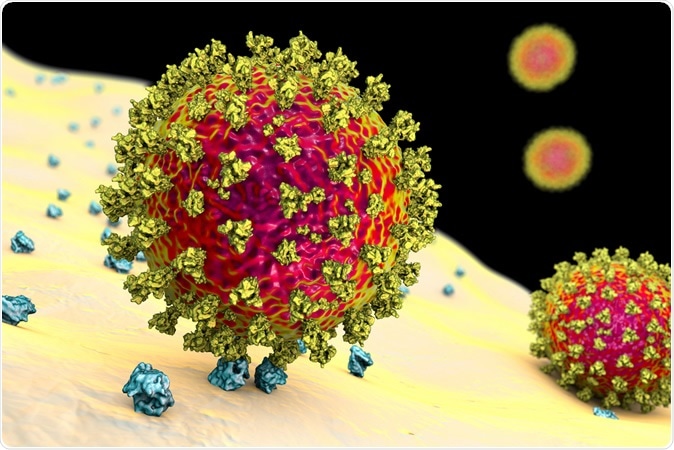A group of researchers from Russia and France has demonstrated how stem cells in the lungs can be readily infected by severe acute respiratory syndrome coronavirus 2 (SARS-CoV-2), leading to significant defects in their regeneration capacity and more severe coronavirus disease (COVID-19). Their manuscript is currently available on the preprint server bioRxiv*.
The emergence of a novel human coronavirus SARS-CoV-2, which causes COVID-19 has turned into a global health concern since its spread is facilitated via droplets, as well as by contaminated hands or surfaces.
Unlike endemic/seasonal human coronaviruses, we are now fully aware of how SARS-CoV-2 can sneak into the lower respiratory tract and give rise to a severe respiratory failure with high case fatality rates.
Consequently, COVID-19 develops due to the infection of epithelial cells found within the two major compartments of the lungs: the conducting airways that warm and cleans the inspired air and the gas-exchanging alveoli that are basically the workhorses of our respiratory tract.
Both the conducting airway and alveolar epithelial cells are specified by relatively slow renewal; however, the pool of cells can be swiftly reconstituted by multipotent stem cells following the infection, injury, or inflammation – all commonly observed in respiratory diseases.
How SARS-CoV-2 enters the cell
The entry of coronaviruses into human cells depends on the binding of the viral spike proteins (S-proteins) to cellular receptors, as well as on S-protein priming by host cell proteases.
SARS-CoV-2 uses angiotensin-converting enzyme 2 (ACE2) for cell entry, which is found throughout the lungs, but predominantly concentrated in type II alveolar cells. Furthermore, TMPRSS2 and FURIN proteases are used for S-protein priming.

The expression of the aforementioned SARS-CoV-2 entry factors can be analyzed in detail by using publicly available RNA-seq datasets. In short, RNA-seq technology represents a sequencing technique that employs next-generation sequencing (NGS) to reveal and quantify RNA in biological samples.
In order to determine whether SARS-CoV-2 can also infect lung stem cells, researchers from Lomonosov Moscow State University, Russian Academy of Sciences, and Université Paris-Saclay in France analyzed the expression of viral entry factors in different epithelial stem cells by utilizing publicly available RNA-seq data.
Cell expression in mice and men
Albeit SARS-CoV-2 can infect lung cells and instigate severe respiratory failure, this distinguishing characteristic of COVID-19 is at odds with recent reports based on single-cell RNA sequencing. The latter indicates that merely a small fraction of epithelial cells in the lower respiratory tract express SARS-CoV-2 entry factors.
This is why study authors reanalyzed the data in these studies in order to detect ACE2-expressing cells. Due to the limited data on lung stem cells in humans, the researchers turned their attention to the data from mice.
Nonetheless, the pattern of SARS-CoV-2 entry factor expression in different human and mouse epithelial cells is highly similar, implying that mice datasets can be objectively used for the analysis of SARS-CoV-2 entry factors in humans.
The expression of SARS-CoV-2 entry factors was analyzed only in basal, club, and ciliated cells, because the number of other types of cells in the full-length scRNA-seq dataset was exceptionally low.
Slow recovery of lung epithelium in COVID-19
"We demonstrated that different lung epithelial stem cells expressed SARS-CoV-2 entry factors and thus could be infected by SARS-CoV-2", study researchers explain their main discovery in a paper currently available on bioRxiv preprint server.
"This ability may account for the slow reconstitution of the lung epithelium during and after SARS-CoV-2 infection and may partially explain the severity of the disease", they add.
The authors also proposed that the expression of ACE2 and other SARS-CoV-2 entry factors might be underestimated as a result of 'drop-out' events - i.e. when a gene is detected in one cell but not in another one. This usually occurs due to extremely low mRNA input, as well as the stochastic nature of gene expression.
"The expression of SARS-CoV-2 entry factors may be a general feature of lung stem cells, making these cells probable targets of SARS-CoV infection in humans", emphasize study authors.
Therefore, the infection of stem cells, followed by their loss, can give rise to a decreased capacity for epithelial regeneration of the lung, which could, in turn, serve as a determinant of SARS-CoV-2 pathogenicity.
Some researchers have already highlighted the efficacy of stem cells in the treatment of severe respiratory issues tied to COVID-19. Findings in this paper may bring us one step closer to the targeted treatment of this severe viral disease.
*Important Notice
bioRxiv publishes preliminary scientific reports that are not peer-reviewed and, therefore, should not be regarded as conclusive, guide clinical practice/health-related behavior, or treated as established information.
https://news.google.com/__i/rss/rd/articles/CBMid2h0dHBzOi8vd3d3Lm5ld3MtbWVkaWNhbC5uZXQvbmV3cy8yMDIwMDUyNS9UaGUtaW5mZWN0aW9uLW9mLWx1bmctc3RlbS1jZWxscy1tYXktZGV0ZXJtaW5lLVNBUlMtQ29WLTItcGF0aG9nZW5pY2l0eS5hc3B40gF7aHR0cHM6Ly93d3cubmV3cy1tZWRpY2FsLm5ldC9hbXAvbmV3cy8yMDIwMDUyNS9UaGUtaW5mZWN0aW9uLW9mLWx1bmctc3RlbS1jZWxscy1tYXktZGV0ZXJtaW5lLVNBUlMtQ29WLTItcGF0aG9nZW5pY2l0eS5hc3B4?oc=5
2020-05-26 00:40:32Z
52780805032652
Bagikan Berita Ini














0 Response to "The infection of lung stem cells may determine SARS-CoV-2 pathogenicity - News-Medical.Net"
Post a Comment